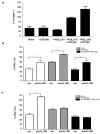Prevention of both direct and cross-priming of antitumor CD8+ T-cell responses following overproduction of prostaglandin E2 by tumor cells in vivo
- PMID: 18794140
- PMCID: PMC2546514
- DOI: 10.1158/0008-5472.CAN-08-1060
Prevention of both direct and cross-priming of antitumor CD8+ T-cell responses following overproduction of prostaglandin E2 by tumor cells in vivo
Abstract
Defects in antitumor immune responses have been associated with increased release of prostaglandin E(2) (PGE(2)) as a result of overexpression of cyclooxygenase (COX)-2 by tumors. In this report, we examine the effects of PGE(2) on antitumor CD8(+) T-cell responses generated both by cross-presenting dendritic cells and by direct priming by tumor cells. Our data show that PGE(2) inhibits dendritic cell maturation, resulting in the abortive activation of naive CD8(+) T cells, and is dependent on interleukin-10 production by dendritic cells. Interaction of tumor cells with naïve CD8(+) T cells in the presence of PGE(2) in vitro results in the induction of CD8(+) CD28(-) T cells, which fail to proliferate or exhibit effector function. In vivo, overexpression of COX-2 by tumor cells results in a decrease in number of tumor-infiltrating dendritic cells and confers the ability of tumor cells to metastasize to the tumor draining lymph nodes.
Figures





References
-
- Almand B, Resser JR, Lindman B, et al. Clinical significance of defective dendritic cell differentiation in cancer. Clin Cancer Res. 2000;6:1755–66. - PubMed
-
- Enk AH, Jonuleit H, Saloga J, Knop J. Dendritic cells as mediators of tumor-induced tolerance in metastatic melanoma. Int J Cancer. 1997;73:309–16. - PubMed
-
- Enk AH, Angeloni VL, Udey MC, Katz SI. Inhibition of Langerhans cell antigen-presenting function by IL-10. A role for IL-10 in induction of tolerance. J Immunol. 1993;151:2390–8. - PubMed
-
- Gabrilovich DI, Ciernik IF, Carbone DP. Dendritic cells in antitumor immune responses. I. Defective antigen presentation in tumor-bearing hosts. Cell Immunol. 1996;170:101–10. - PubMed
Publication types
MeSH terms
Substances
Grants and funding
LinkOut - more resources
Full Text Sources
Other Literature Sources
Medical
Research Materials

